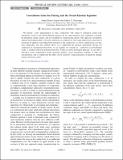Correlations from Ion Pairing and the Nernst-Einstein Equation
Author(s)
France-Lanord, Arthur; Grossman, Jeffrey C.
DownloadPublished version (417.1Kb)
Terms of use
Metadata
Show full item recordAbstract
We present a new approximation to ionic conductivity well suited to dynamical atomic-scale simulations, based on the Nernst-Einstein equation. In our approximation, ionic aggregates constitute the elementary charge carriers, and are considered as noninteracting species. This approach conveniently captures the dominant effect of ion-ion correlations on conductivity, short range interactions in the form of clustering. In addition to providing better estimates to the conductivity at a lower computational cost than exact approaches, this new method allows us to understand the physical mechanisms driving ion conduction in concentrated electrolytes. As an example, we consider Li+ conduction in poly(ethylene oxide), a standard solid-state polymer electrolyte. Using our newly developed approach, we are able to reproduce recent experimental results reporting negative cation transference numbers at high salt concentrations, and to confirm that this effect can be caused by a large population of negatively charged clusters involving cations.
Date issued
2019-04Department
Massachusetts Institute of Technology. Research Laboratory of Electronics; Massachusetts Institute of Technology. Department of Materials Science and EngineeringJournal
Physical Review Letters
Publisher
American Physical Society (APS)
Citation
France-Lanord, Arthur, and Jeffrey C. Grossman. “Correlations from Ion Pairing and the Nernst-Einstein Equation.” Physical Review Letters 122, 13 (April 2019): 136001. © 2019 American Physical Society
Version: Final published version
ISSN
1079-7114
0031-9007